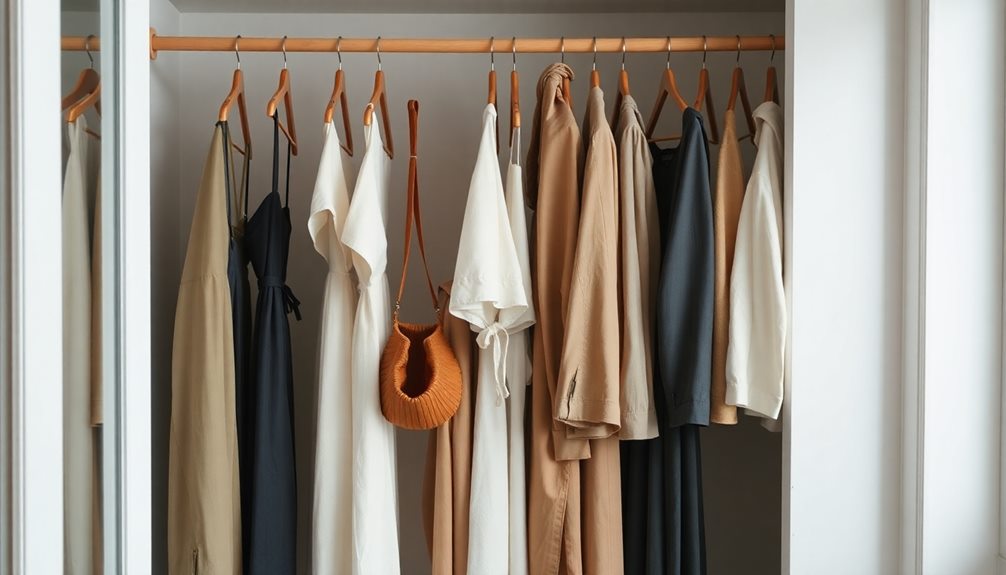To find gems while saving the planet, shop during weekdays and in affluent neighborhoods for better quality items. Develop your eye for authenticity and craftsmanship by inspecting fabrics, tags, and stitching. Be patient and open-minded, browsing thoroughly without rushing. Focus on high-value, timeless pieces that fit your style, and organize your space beforehand. Supporting sustainability also means upcycling and maintaining your thrifted treasures—stay tuned to discover more strategies for successful thrifting.
Key Takeaways
- Shop during weekdays and mornings to find fresh stock and less crowded stores.
- Inspect fabrics, stitching, and authenticity marks to select high-quality, genuine items.
- Stay patient, open-minded, and strategic; browse thoroughly and avoid impulsive buys.
- Focus on timeless, well-made pieces that complement your wardrobe and support sustainability.
- Organize your space and define your style to target items efficiently and maximize thrifted treasures.
Know When and Where to Shop for the Best Finds
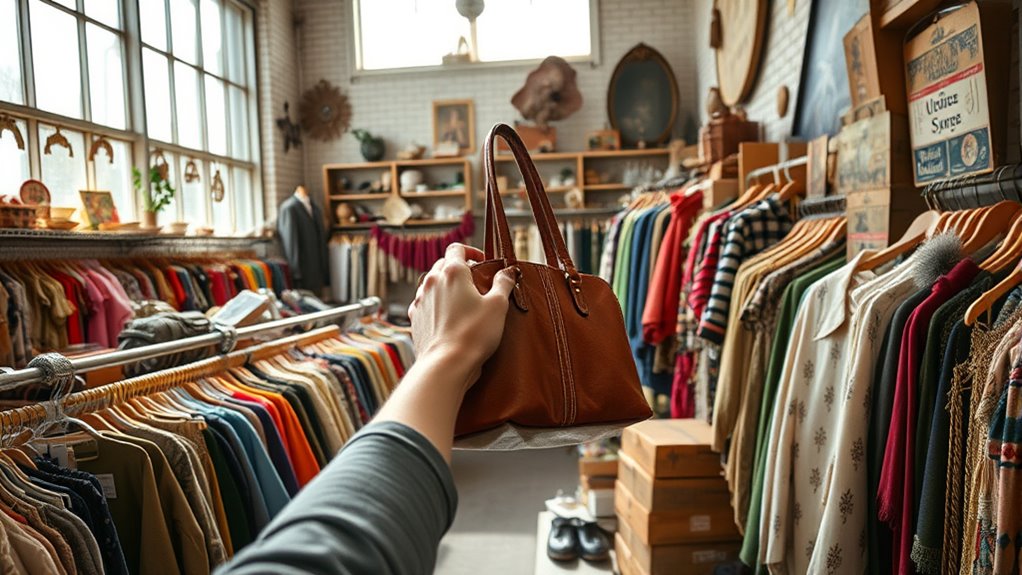
Knowing the right times and places to shop can make all the difference when hunting for great thrift store finds. Weekdays, especially mornings, are ideal since stores are less crowded and freshly stocked. Avoid weekends or late afternoons when shelves are often picked over. Target specific days when stores receive donations or restock their inventory—many do so mid-week. Visit popular thrift shops in affluent neighborhoods or areas with high turnover, as they tend to have better quality items. Don’t overlook seasonal sales or special events like donation drives, which can bring in unique pieces. Additionally, explore local community sales, charity shops, or garage sales for hidden treasures. Planning your shopping trips around these times boosts your chances of scoring quality, one-of-a-kind items. Being aware of inventory turnover can help you time your visits for the best selection.
Develop a Keen Eye for Quality and Authenticity
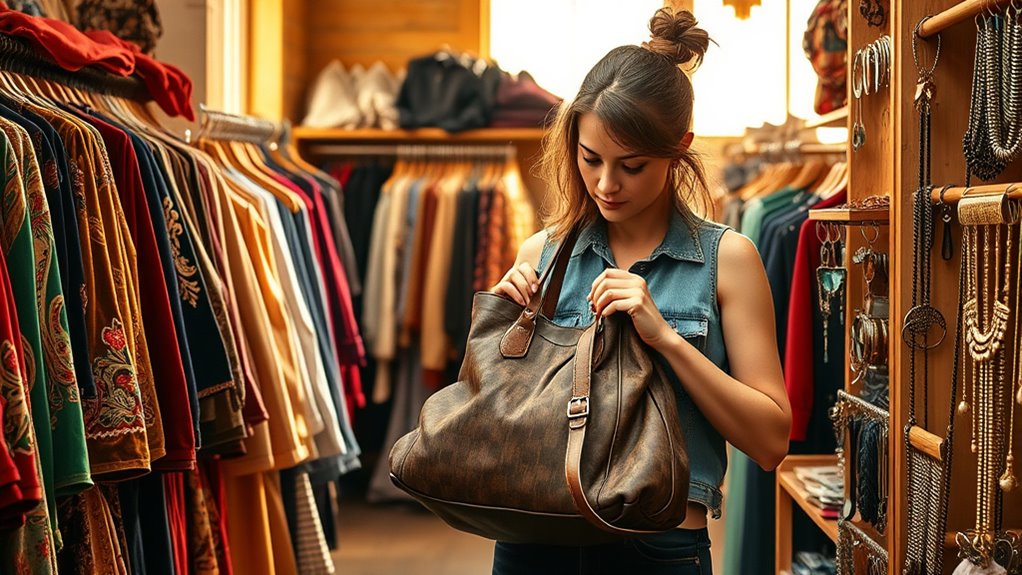
Developing a keen eye for quality and authenticity is essential to making successful thrift store finds. First, inspect fabric labels and stitching—well-made items often have tight, even seams and durable materials. Feel the fabric; high-quality pieces tend to be thicker and softer, indicating better craftsmanship. Look for signs of wear that are consistent with age, like natural patina on leather or vintage fading, which can add character. When evaluating brand-name items, research logos and tags to spot fakes. Check for authenticity marks or unique details that genuine pieces typically have. Trust your instincts: if something feels cheap or looks suspicious, pass it by. Additionally, understanding the horsepower of electric dirt bikes can help you gauge the quality and performance of certain items, as high horsepower often correlates with better craftsmanship and energy efficiency. Recognizing authenticity features can further ensure your thrifted treasures are genuine and worth the investment. Moreover, becoming familiar with quality indicators can help you distinguish between well-made and poorly manufactured items at a glance. Gaining knowledge of cultural trends can also guide you toward pieces that are both fashionable and durable, increasing the value of your thrifted finds.
Be Patient and Open-Minded During Your Search

Being patient and open-minded helps you notice unexpected finds and unique pieces you might otherwise overlook. Rushing your decision can cause you to miss great opportunities, so take your time to browse thoroughly. Keep an open mind, and you’ll discover treasures that fit your style in the most surprising places. Paying attention to efficient ledger coding can also help you make smarter purchasing decisions by understanding the value of your finds. Additionally, understanding the types of divorce and their implications can provide clarity and reduce stress during emotional upheavals. Being aware of currency fluctuations can help you better evaluate the true worth of your finds when shopping internationally. Moreover, gaining knowledge about Gold IRA rollover process can inform your financial decisions if you consider investing in precious metals as part of your savings strategy. Recognizing merchant service drawbacks can help you navigate potential costs and limitations more effectively.
Embrace Unexpected Finds
Have you ever stumbled upon a hidden gem when least expecting it? Thrift shopping is full of surprises, and that’s part of the fun. Keep an open mind and be ready for anything. Sometimes, the most unassuming items turn out to be unique treasures that no one else will have. Don’t dismiss something just because it’s not what you initially sought. Instead, consider its potential and how it could fit into your style or home. Patience is key—digging through racks and shelves might take time, but the payoff is worth it. Embracing unexpected finds means trusting your instincts and remaining flexible. You never know when a quirky vintage piece or a rare item might be waiting just around the corner. Also, understanding color accuracy and other qualities can help you assess the value and uniqueness of items more effectively. Paying attention to cryptocurrency regulations can also help you navigate your shopping experience more confidently, especially if you’re dealing with digital or designer items. Stay curious, and enjoy the thrill of discovery.
Avoid Rushing Selection
While it’s tempting to make quick decisions, rushing through thrift stores can cause you to overlook hidden treasures. Take your time to explore each section thoroughly, inspecting items carefully rather than grabbing the first thing that catches your eye. Be patient and resist the urge to rush your browsing. Sometimes, the best finds are tucked away or buried among less appealing items. If you’re unsure about a piece, hold onto it and consider it for a moment. Rushing can lead to impulsive purchases or passing by unique items. Remember, thrift shopping is about discovering quality and character, not speed. Developing a mindful approach can help you stay focused and appreciative during your search, enhancing your overall experience. By staying calm and deliberate, you give yourself a better chance to find gems that truly suit your style and needs. Practicing patience can also reduce the risk of impulsive buying, helping you make more mindful choices. Developing a positive mindset can enhance your overall thrift shopping experience by attracting better opportunities and more satisfying finds.
Keep an Open Mind
Keeping an open mind while thrift shopping can reveal unexpected treasures you might not have considered at first glance. Don’t dismiss items too quickly; sometimes the perfect find needs a little imagination. Patience is key—dig through racks, shelves, and bins without rushing. You might stumble upon vintage jackets, unique decor, or retro accessories that stand out once you see their potential. To visualize, consider this table:
| Item Type | Possible Finds | Styling Ideas |
|---|---|---|
| Clothing | Retro dresses, jackets | Pair with modern shoes |
| Home Decor | Framed art, vases | Mix old and new for charm |
| Accessories | Scarves, jewelry | Add a pop of color or sparkle |
| Footwear | Boots, sneakers | Customize or wear as-is |
Stay patient and keep an open mind to turn thrift shopping into a rewarding adventure. Exploring vetted global world options can also introduce you to unique, eco-friendly pieces that align with sustainable practices. Moreover, understanding home decor styles can help you recognize quality and potential in secondhand items, making your searches more targeted and fruitful. Additionally, researching local thrift stores can help you discover hidden gems close to home, making your search more efficient and enjoyable.
Learn to Spot High-Value and Timeless Pieces
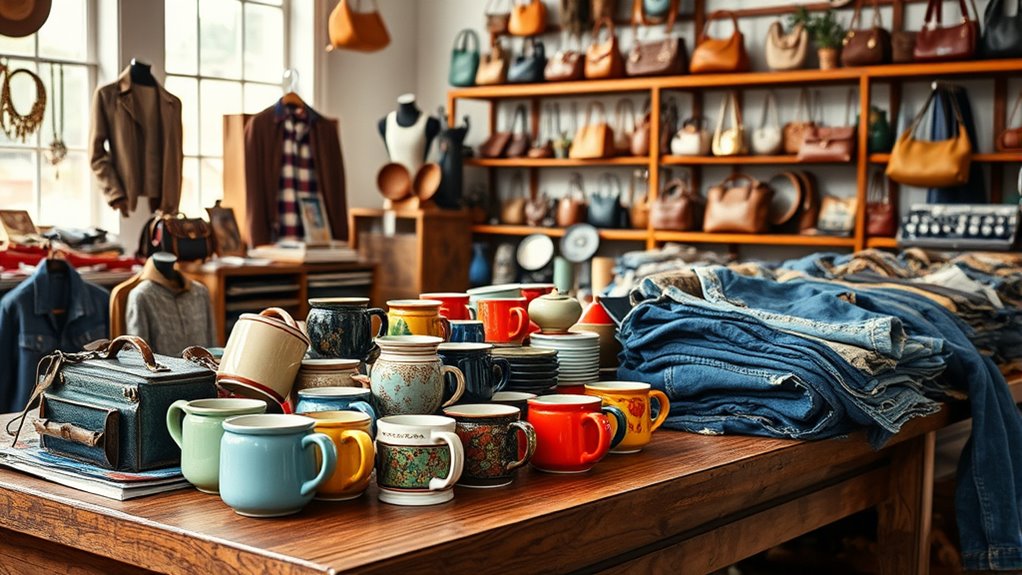
How can you identify high-value and timeless pieces among the many items at a thrift store? Focus on classic styles that never go out of fashion, like a tailored blazer or a simple trench coat. Look for well-made fabrics such as wool, silk, or high-quality cotton, which tend to last longer. Check labels for designer brands or vintage labels known for quality. Examine the stitching and construction—solid seams and sturdy buttons indicate durability. Avoid overly trendy or heavily branded items that may quickly fade in popularity. Opt for versatile pieces that can be styled with multiple outfits. Remember, timeless pieces often have a subtle elegance and neutral colors that make them easy to incorporate into your wardrobe for years to come. Additionally, understanding sound healing science can enhance your awareness of how certain materials and textures might contribute to a calming and balanced environment in your wardrobe or home. Recognizing authentic craftsmanship can also help you distinguish genuinely high-quality items from imitation or poorly made pieces. Paying attention to material quality can further help you select pieces that will stand the test of time. Being familiar with sustainable fashion practices can guide you toward making eco-friendly choices when thrift shopping. Moreover, considering the environmental impact of textiles can help you make more conscious decisions that support overall sustainability.
Prepare Your Space and Style Before Shopping

Before you start shopping, clear and organize your space so you can see what you already have. Define your style to focus your search on pieces that truly fit your look, saving time and effort. Setting a budget helps you stay on track and avoid impulse buys, making your thrifting more enjoyable and effective. Incorporating sustainable luxury travel principles can enhance your eco-conscious shopping habits, aligning your style with your values. Understanding the weight of items can also help you plan transportation and avoid overloading your vehicle. Additionally, considering the portability of items can ensure they are practical for your lifestyle and storage space.
Organize Your Space
Organizing your space before shopping helps you clarify your style and avoid impulse buys. When your area is tidy and well-arranged, you can focus on what truly fits your aesthetic and needs. Clear off surfaces, sort through your current belongings, and identify gaps or items you want to replace. This preparation keeps you grounded and prevents unnecessary clutter from influencing your choices. Imagine a clean, well-lit corner with labeled bins for different categories—clothes, accessories, or shoes. Visualize a dedicated space where you can easily see what you already own. By setting up your space beforehand, you streamline the shopping experience, stay focused on your goals, and make more intentional, satisfying finds.
Define Your Style
Having a clear sense of your personal style is essential before heading to the thrift store. Knowing what looks good on you and reflects your personality helps you focus your search and avoid impulse buys. Take time to define your style—whether it’s boho, classic, edgy, or vintage. Browse magazines, social media, or your closet to identify patterns and favorite colors. Create a mood board or list key pieces you want, like a denim jacket or flowy skirts. This preparation keeps you targeted and efficient, saving time and reducing overwhelm. Remember, thrift shopping is about finding unique pieces that fit your personality, so stay true to your style. Clear goals make the process enjoyable and increase your chances of scoring true gems.
Set a Budget
Setting a budget is a pivotal step that keeps your thrift shopping focused and stress-free. Before heading out, decide how much you’re willing to spend. This helps you avoid impulse buys and stay true to your style. Prepare your space by clearing a dedicated area for new finds, so you can visualize how they’ll fit into your wardrobe. Think about your main priorities—are you looking for statement pieces, everyday essentials, or unique accessories? By setting clear limits and goals, you’ll shop more intentionally.
- Visualize your space with an empty corner or box for new treasures
- Know your price range to avoid overspending
- Focus on styles and items that fit your wardrobe needs
Maintain and Upcycle Items to Maximize Their Lifespan
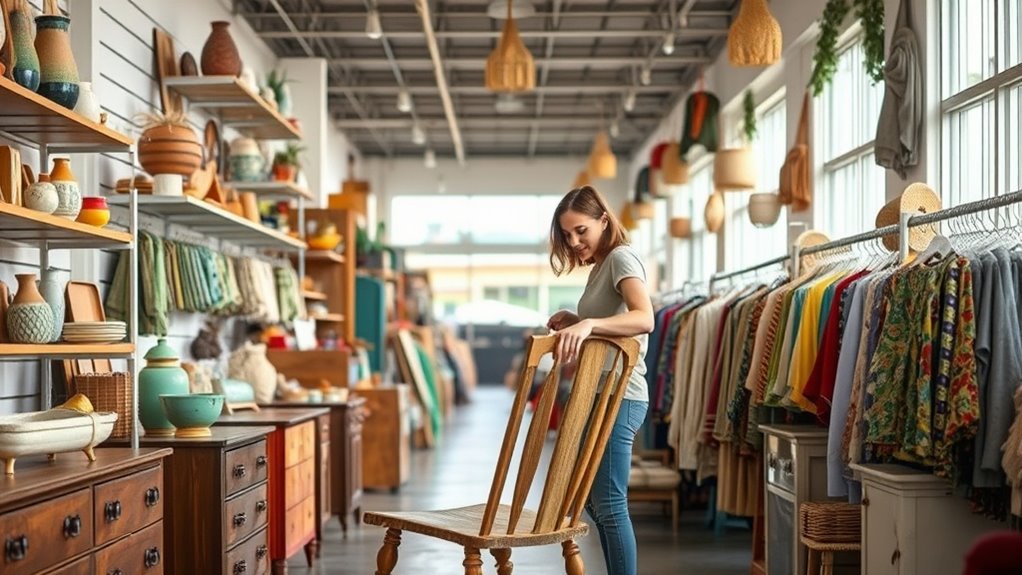
Maintaining and upcycling your thrifted items can considerably extend their usefulness and save you money in the long run. Regular care like cleaning, repairing, or replacing worn parts keeps items functional and looking fresh. For clothing, follow care labels, mend small tears, or dye faded fabrics to revive their appearance. For furniture, tighten loose joints, sand rough surfaces, or repaint to give pieces new life. Upcycling adds a creative touch—transform old jars into lanterns or repurpose furniture with paint or fabric. These efforts not only reduce waste but also maximize your investment. By taking a little time to maintain and upcycle, you ensure your thrifted finds stay attractive and functional longer, helping you enjoy your treasures while supporting sustainable shopping habits.
Frequently Asked Questions
How Can I Identify Eco-Friendly or Sustainable Thrift Stores?
You want to find eco-friendly or sustainable thrift stores, right? Start by researching stores that openly promote sustainable practices, like recycling or eco-conscious sourcing. Look for certifications or labels indicating sustainability. Check their website or social media for info on eco initiatives. Visit stores and ask staff about their sustainability efforts. Supporting local, small-scale thrift shops often means you’re contributing to greener practices, too.
What Are Common Signs of Authentic Vintage Items?
Think of vintage items as time capsules—each tells a story. To spot authenticity, look for signs like unique tags, original stitching, and fabric labels that match the era. Check for wear consistent with age, such as patina or fading, but avoid overly perfect pieces. Research brands and styles from specific decades. Trust your instincts and examine details closely to verify you’re holding a genuine treasure, not a replica.
How Do I Estimate the Value of Thrifted Clothing?
To estimate the value of thrifted clothing, start by examining the brand, condition, and rarity of the piece. Check for tags or labels that might indicate designer or vintage status. Research similar items online to compare prices. Consider the item’s age, uniqueness, and demand, as these factors influence its worth. Remember, a well-maintained piece in excellent condition usually commands a higher price.
What Safety Precautions Should I Take When Shopping at Thrift Stores?
When shopping at thrift stores, you should prioritize safety. Always wear sturdy shoes, especially if you’re walking through uneven floors. Use hand sanitizer after touching items, and wash clothes thoroughly before wearing. Keep your belongings close to avoid theft, and be cautious around sharp objects or broken items. Trust your instincts—if something feels unsafe or dirty, it’s best to skip it. Staying alert keeps your thrift shopping fun and secure.
Are There Specific Seasons or Times Best for Thrift Shopping?
You might think thrift shopping is random, but timing can make a big difference. The best seasons are spring and fall, when stores clear out seasonal items, giving you more variety and better deals. Weekdays often see fewer shoppers, so you can browse more comfortably. Planning your visits around these times helps you find hidden gems, save money, and enjoy a less hectic shopping experience.
Conclusion
By blending patience with passion, you’ll master the art of thrift shopping. Seek out stylish surprises, stay sincere in your search, and savor sustainable savings. With a keen eye, open mind, and a touch of creativity, you’ll uncover unique treasures that not only elevate your style but also support a healthier planet. So, stay spirited, stay sustainable, and let your thrift journey thrive with thoughtful finds and eco-friendly flair.


